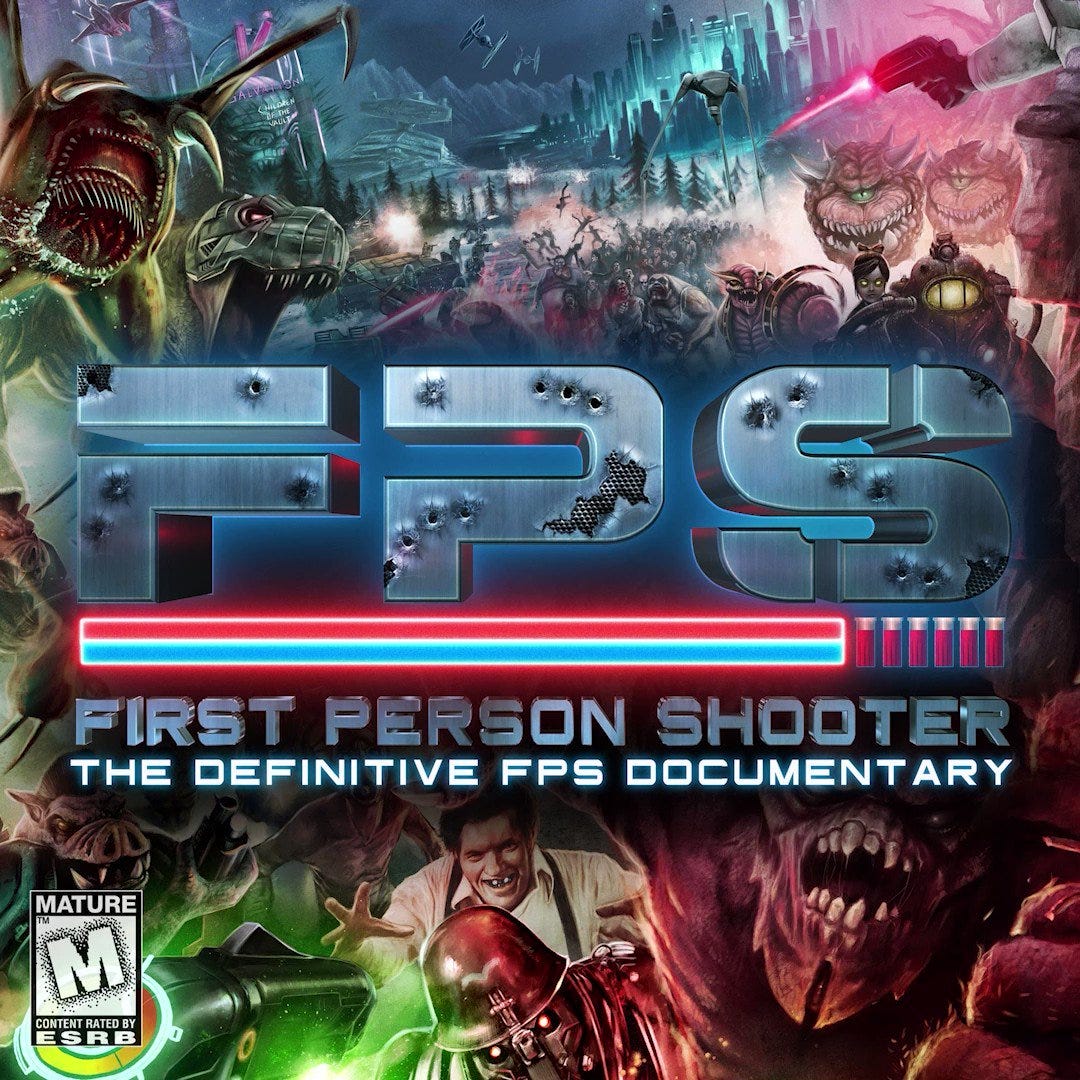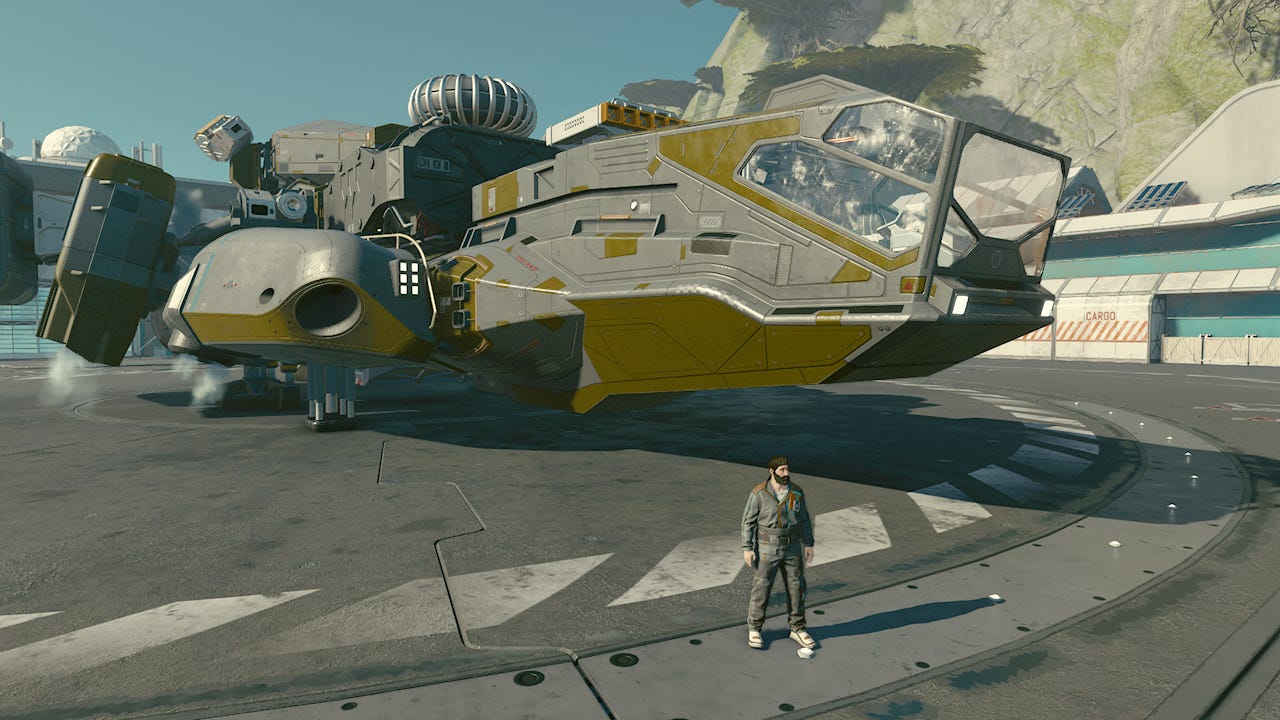Weekend Gaming Roundup with FPS: First Person Shooter and Starfield
A gaming documentary and Bethesda’s latest RPG
I haven’t devoted many words to video games in this Substack over the last two years. Comic books, movies, television shows, and novels have been the focus up to this point, but this extended weekend has put video games in the spotlight with two hotly anticipated properties. I got the opportunity to watch FPS: First Person Shooter, a documentary chronicling the history of one of the most infamous genres of video games. I also got my hands on Starfield, the latest ambitious role playing game from Bethesda. Did either live up to my expectations? Let’s dive in and find out!
FPS: First Person Shooter
FPS: First Person Shooter bills itself as “the definitive FPS documentary,” and it’s tough to argue with that claim. Granted part of that is due to there not exactly being a plethora of documentaries on the subject, but it’s difficult to imagine a documentary as thorough and polished as this one.
Directed by David L. Craddock and Christopher Stratton with writing credits going to Craddock and Richard Moss, FPS devotes an astounding four hours and thirty-five minutes of runtime to covering the history of the genre as told by the people responsible for creating the most influential games that compose it. There are some obvious inclusions (Wolfenstein 3D, Doom, Quake, GoldenEye 007, Half-Life, Halo, etc.), but there are some less obvious games and their creators that are featured that really helped flesh out the humble beginnings of the genre.
The format of the documentary is a familiar one if you’ve seen any of the documentaries produced by CreatorVC Studios, the company responsible for producing the In Search of Darkness documentary series on horror films. The viewer is presented with a wall of video game box art, and the camera settles on whichever game will be discussed next in chronological order. From there, the viewer is treated to a series of interviews with industry figures and fans intercut with gameplay as the history and importance of that game is discussed.
If there is a “star” of the documentary, it would be John Romero. Romero is the co-founder of id Studios and served as programmer and designer on games like Wolfenstein 3D, Doom, and Quake among many others. The aging gamer and metalhead has a magnetic personality and exuberance that makes his interviews really stand out and push the film forward.
Overall I found FPS: First Person Shooter to be utterly engrossing and entertaining. The length may seem daunting, but it is easily watched over the course of multiple sittings due to its segmented nature. It is mandatory viewing for anyone who considers themselves a fan of video games.
Starfield
Let’s take a trip back to the summer of 2002. I was seventeen years old and the proud owner of a first generation Xbox which had just debuted less than a year earlier. Up to that point, I was primarily playing Halo like everyone else who had bought an Xbox when it launched (you haven’t lived until you and fifteen of your buddies have played Halo in the same house with four Xboxes hooked together with ethernet cables). That summer is when I picked up a game that hit shelves without a ton of fanfare named The Elder Scrolls III: Morrowind from a company called Bethesda Softworks. Morrowind was a role-playing game set in a pretty traditional medieval fantasy world. My experience with role-playing games at that point was less than extensive and was primarily limited to The Legend of Zelda franchise, so I didn’t really know what to expect from this game. I’m not exaggerating when I say that playing Morrowind fundamentally altered my expectations for what a role-playing game could and should be. I had never experienced such a rich and open world in a video game before that was filled to the brim with side quests and fascinating non-playable characters with their own unique personalities and backstories. I was immediately hooked, and the Bethesda style became my benchmark for the genre.
Flash forward to today, and Bethesda has released their most ambitious role-playing game yet with the space exploration and action epic called Starfield. Starfield allows players to create and guide a character looking to make their own way in the Milky Way galaxy in the far flung future of 2310. Much like games in Bethesda’s other franchises (the medieval fantasy world of The Elder Scrolls and the post-apocalyptic world of Fallout), Starfield is an open world made up of over a thousand different explorable planets, moons, and space stations populated by a seemingly limitless number of non-playable characters with numerous quests and missions that players can participate in at their own discretion.
As of this writing, I have sunk just under twenty-three hours of gameplay into Starfield, and it feels like I have barely scratched the surface of what the game has to offer. The basics of the game are as follows. Players have a spaceship that they can use to travel throughout the galaxy by hopping from one solar system to another. Each solar system has its own explorable planets and moons that players can visit. Those worlds can have one or more outposts populated with non-playable characters that the player can interact with which includes buying and selling goods, completing missions, or even hiring to become part of your crew. These worlds are also populated with antagonists in the form of members of rival factions, pirates, wild animals, and monsters. While making your way through the galaxy, you can earn credits (the game’s currency) to buy better weapons, spacesuits, and ships. You can also set up outposts on these worlds to harvest resources. Acquiring a new spaceship and exploring its interior is a true joy.
There are two primary forms of gameplay within Starfield. The most common is exploring worlds on foot and going through various cities and outposts. You can do so through a first person perspective, a third person over the shoulder perspective, or a full third person perspective. I prefer first person, but that’s just me. The other form of gameplay involves piloting your ship. This can be done via first person or third person perspective. While piloting your ship within a solar system, you can engage enemy ships in dogfights and choose different locations to dock and explore. Unfortunately, you can’t merely fly from one system to another seamlessly. That is done by load screens. I’ve seen some complaints about that feature, but it’s a minor quibble in my opinion. Planets and moons also are not completely open world. You can explore certain areas, but there is an invisible boundary that you’ll eventually hit if you just walk in one direction forever. While this has been a sticking point for some, I can honestly say that I have not once actually found one of these boundaries while exploring.
Easily the biggest improvement in Starfield from Bethesda’s previous games is the combat system. Getting into gun battles with swarms of enemies feels much more fluid and realistic than their previous offerings. It’s easy to cycle through weapons and engage adversaries without having to spend time thinking about menu screens. It’s much more in line with first person shooters than a traditional RPG in that regard.
Starfield also boasts some incredible visuals. Whether it’s looking up in the night sky from a moon and seeing the planet you’re orbiting or watching as lasers and bullets streak across the screen in a firefight, the game simply looks incredible. That’s especially impressive considering just how large in scope the world is.
I think the best way to convey the allure of Starfield and its open world mechanics is to run through an actual experience I had at a high level. I had just entered a new solar system for the first time and arrived just outside of one of the planets there. While just outside that planet’s gravitational pull, I noticed there was a space station orbiting it. I selected the space station and attempted to make contact with those aboard, but I got nothing but static in response. I decided to go ahead and dock with the space station anyway and board it. Once inside, I realized that there was no gravity inside and would need to explore while wearing a spacesuit. While exploring the space station, I came into contact with a group of enemies called Spacers and proceeded to get into a zero gravity firefight with them. Once clearing them out, I searched their bodies and discovered a recording one of them had that clued me in on another solar system somewhere in the galaxy that would launch me into a new mission were I to explore it that could end up providing me with some cool new weapons and equipment.
Literally none of these actions were mandated by the game. I visited that solar system arbitrarily, and the space station I docked with was also by my own decision. It’s this kind of open world gaming that makes playing Starfield such a rewarding experience, and it has quickly become one of my favorite games in years. If open world role-playing games are your idea of fun, then Starfield is an essential game for you to own if you have an Xbox or PC.







